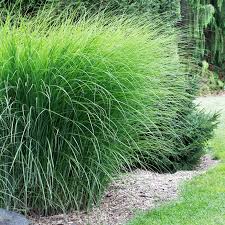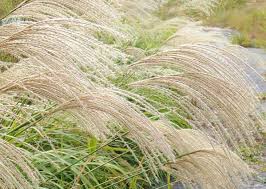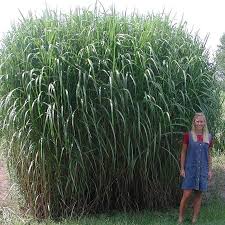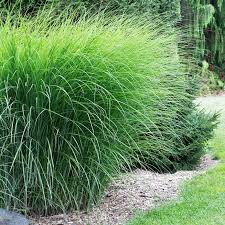Miscanthus grass, also known as Miscanthus × giganteus in the science world, is a really cool plant that comes from Asia. It’s a big grass that can grow super tall, like up to 10 feet or even more! When it gets a bit older, it shows off these fancy fluffy parts that look like feathers, and they come out in late summer. People love to put it in their gardens because it looks nice and adds a touch of fancy.
But guess what? This grass isn’t just a pretty face. It’s got some other tricks up its sleeve too. One of the neatest things is that it can be turned into energy. Yep, you read that right – energy! See, this grass grows really fast and has a lot of stuff in it that can be used to make clean energy. That means it can help make electricity without using yucky things that hurt the planet. Pretty awesome, right?
Oh, and here’s something else cool: this grass is like a superhero for the earth. Its roots go really deep into the ground, like a secret underground team, and they do a bunch of important jobs. They stop the soil from washing away when it rains a lot, which helps keep the land nice and healthy. They also take carbon from the air and lock it away in the soil, which is like a natural way of fighting climate change.
Farmers like to use this grass too because it’s like a superhero for their fields. It can grow in lots of different types of soil, and it doesn’t get sick easily. This means farmers can use it to help their other crops grow better, kind of like a friendly neighbor that helps out.
Gardeners really dig this grass because it’s easy to take care of and looks good all year round. You can put it in your garden and it’ll stand tall and sway in the breeze, making your yard look super fancy. It doesn’t matter if you’re new to gardening or a pro – this grass is a great choice.
So, there you have it! Miscanthus grass, or Miscanthus × giganteus if you want to be fancy, is a big, beautiful plant that’s not only a feast for the eyes but also a helper for the environment and a friend to farmers and gardeners alike. It’s like nature’s own superhero, making the world a better place in its own unique way.
Read Also: Harvesting and Processing Of Cacao Fruits
Growing and Care Guide of Miscanthus Grass

Here’s a simple growing and care guide for Miscanthus grass:
Growing Miscanthus Grass
1. Choose the Right Spot: Pick a sunny spot in your garden. Miscanthus grass loves sunlight, so make sure it gets at least 6 hours of direct sunlight each day.
2. Prepare the Soil: Make sure the soil is well-draining and has good fertility. You can add compost to enrich the soil before planting.
3. Planting: You can plant Miscanthus grass either in spring or fall. Dig a hole that’s about twice as wide as the root ball of the plant. Place the plant in the hole, fill it with soil, and pat it down gently.
4. Spacing: Give each plant enough space to grow. Depending on the variety, space them about 3 to 5 feet apart.
5. Watering: Water the grass regularly after planting, especially during the first growing season. Once established, Miscanthus is drought-tolerant, but it’s a good idea to water during dry spells.
Care Tips for Miscanthus Grass
1. Mulching: Spread a layer of mulch around the base of the plant to help retain moisture and prevent weeds. Make sure the mulch doesn’t touch the stem of the grass.
2. Pruning: In late winter or early spring, trim back the grass to about 6 inches above the ground. This helps promote new growth and keeps the plant looking neat.
3. Fertilizing: You can feed Miscanthus grass with a balanced, slow-release fertilizer in the spring. Follow the package instructions for the right amount to use.
4. Division: Every few years, your Miscanthus grass might get a bit crowded. You can divide the plant by digging it up, splitting the clumps, and replanting them. This helps keep the plant healthy and vigorous.
5. Pest and Disease Control: Miscanthus grass is generally resistant to pests and diseases. Keep an eye out for any unusual signs and treat as needed with appropriate measures.
6. Overwintering: Miscanthus is hardy and can withstand cold winters. You can leave the grass standing through the winter for some added interest in your garden.
7. Cleanup: In late winter or early spring, you can remove any dead or damaged leaves to tidy up the appearance of the plant.
Remember, Miscanthus grass is pretty low-maintenance once it’s established. It’s a tough plant that can handle different conditions, making it a great choice for both beginners and experienced gardeners. With a little care, you’ll be able to enjoy its tall, graceful beauty and all the benefits it brings to your garden.
Miscanthus Sinensis

Miscanthus sinensis, also known as Chinese silver grass, is a wonderful plant that brings a touch of elegance to gardens and landscapes. With its feathery plumes and graceful sway in the wind, it’s like nature’s own dancer.
This plant comes from Asia and is loved by gardeners for its beauty and ease of care. Its leaves are long and narrow, like little green ribbons that rustle when the breeze tickles them. But the real showstopper is when it puts on its fluffy flower display in late summer and fall. These fluffy parts, called plumes, come in different colors, from creamy white to shades of pink and even purple, adding a burst of color to your garden.
Growing Miscanthus sinensis is a breeze. Find a sunny spot in your garden – this plant loves soaking up the sun. Dig a hole, pop the plant in, and cover its roots with soil. Water it well, especially in the beginning, to help it settle in. Once it’s established, you won’t need to babysit it too much. It’s pretty good at taking care of itself!
One of the cool things about Miscanthus sinensis is that it’s like a superhero for your garden. Its strong roots help prevent soil from washing away during heavy rains, which is great for the earth. Plus, it’s not too picky about soil types, so it can grow in all sorts of places.
If you’re worried about pests bugging your plants, you’re in luck – Miscanthus sinensis isn’t a favorite snack for most critters. This means you can enjoy its beauty without having to wage war on pests.
When winter comes around, you can leave the plant standing tall. It’ll add some interest to your winter garden and provide shelter for birds and insects. Then, in spring, you can give it a little trim to make space for new growth.
So, whether you’re a seasoned gardener or just getting started, Miscanthus sinensis is a great choice. It’s like a natural artist, painting your garden with its flowing leaves and delicate plumes. With a bit of sun and some love, you’ll have a front-row seat to its graceful dance all year round.
Miscanthus Giganteus

Miscanthus Giganteus, sometimes called giant miscanthus, is a special type of grass that’s pretty amazing. Imagine a grass that grows super tall, like a giant in the plant world!
This grass is like a superhero for the environment. It’s great at taking carbon dioxide from the air and turning it into plant stuff. This is like nature’s way of helping to fight climate change. And guess what? It’s also good at preventing soil from washing away, sort of like a natural soil protector.
Farmers really like Miscanthus giganteus because it’s a helpful friend to their fields. It can grow in all sorts of places, from sunny spots to shadier areas. Plus, it doesn’t complain much and doesn’t get sick easily. This makes it a real champ when it comes to being a low-maintenance plant.
Now, the really cool part is that Miscanthus giganteus can be turned into energy. Yep, you read that right – energy! This grass can be used to make electricity and other cool things. Its fast growth and the stuff inside it make it a renewable resource, which means it’s a smart choice for a greener world.
So, if you want to have a superhero grass in your garden, Miscanthus giganteus is the way to go. It’s not just a tall plant, it’s a tall plant with a mission – to make the Earth a better place for everyone.
Read Also: Collection, Handling, Storage and Pre-Treatment of Seeds
Miscanthus Gracillimus

Miscanthus Gracillimus, also known as maiden grass, is a graceful and elegant plant that can add a touch of beauty to your garden. Just imagine delicate leaves swaying in the breeze, creating a calming and soothing atmosphere.
This grass is like a natural artist with its fine-textured leaves that look like soft brushes. It’s a bit smaller than some other Miscanthus varieties, but its charm is no less impressive. In late summer and early fall, it puts on a show with its feathery plumes that dance in the wind, making your garden come alive.
Growing Miscanthus gracillimus is pretty easy. It likes sunshine, so find a sunny spot in your garden where it can soak up those rays. Dig a hole, plant it, and water it well. Once it’s settled in, it won’t need too much attention from you.
One of the coolest things about this grass is its adaptability. It can handle different types of soil, from sandy to clayey, and it’s not too picky about water either. This makes it a great choice for all sorts of gardens.
If you’re looking for a plant that attracts attention but doesn’t demand constant care, Miscanthus gracillimus is a fantastic choice. Its slender leaves and airy plumes make it a standout in any landscape. Whether you’re a seasoned gardener or just starting out, this grass will bring a touch of elegance and tranquility to your outdoor space.
Read Also: Everything You Need to Know About Recycling Equipment
